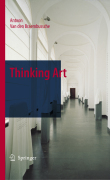
In the twentieth century, avant-garde movements have pushed the concept of art far beyond its traditional boundaries. In this dynamical process of constantrenewal the prestige of thinking about art as a legitimizing practice has come to the fore. So it is hardly surprising that the past decades have been characterized by a revival or even breakthrough of philosophy of art as a discipline. However, the majority of books on aesthetics fail to combine a systematical philosophical discourse with a real exploration of art practice. Thinking Art attempts to deal with this traditional shortcoming. It is indeed not only aneasily accessible and systematic account of the classical, modern and postmodern theories of art, but also concludes each chapter with an artist’s studio in which the practical relevance of the discussed theory is amply demonstrated by concrete examples. Moreover, each chapter ends with a section on further reading, in which all relevant literature is discussed in detail. Thinking Art provides its readers with a theoretical framework that can be used to think about art from a variety of perspectives. More particularly it shows how a fruitful cross-fertilization between theory and practice can be created. This book can be used as a handbook within departments of philosophy, history of art, media and cultural studies, cultural history and, of course, within art academies. Though the book explores theories of art from Plato to Derrida it does not presuppose any acquaintance with philosophy from its readers. It can thus be read also by artists, art critics, museum directors and anyone interested in themeaning of art. One of the most systematic and comprehensive introductions tophilosophy of art existing to-day (classical, modern and post-modern theoriesof art are discussed at length) One of the most readable introductions to philosophy of art: an ideal book to teach philosophy of art and to be read by thegeneral public One of the very few introductions to philosophy of art which shows why philosophy is relevant for artistic practice by way of its segments on ‘The Artist’s Studio’ One of the very few books on philosophy of art containing a widely commented and fully updated bibliography INDICE: Preface, Chapter 1, Introduction: What is Philosophy of Art? Part One ,The Nature of Art: Classical Answers to the Question 'What is Art?'.- Chapter 2,The Imitation Theory.- Chapter 3, Expressive Theories.- Chapter 4, Formalism.- Chapter 5,Art as Synthesis of Form and Expression.- Chapter 6,Aesthetic Judgment: The Legacy of Kant.- Part Two,Art in A Historical and Social Perspective.- Chapter 7,'The End of Art': The Contemporary Interest in Hegel.- Chapter 8, Art and Society: A Neomarxist Perspective.- Part Three, The Language ofArt: From Phenomenology to poststructuralism.- Chapter 9, The Phenomenological perspective.- Chapter 10, Formalism from a Modern Outlook: The Semiotic Perspective.- Chapter 11, The Post-Structuralist Perspective.- Chapter 12 Epilogue.
- ISBN: 978-1-4020-5637-6
- Editorial: Springer
- Encuadernacion: Cartoné
- Páginas: 400
- Fecha Publicación: 18/09/2009
- Nº Volúmenes: 1
- Idioma: Inglés
